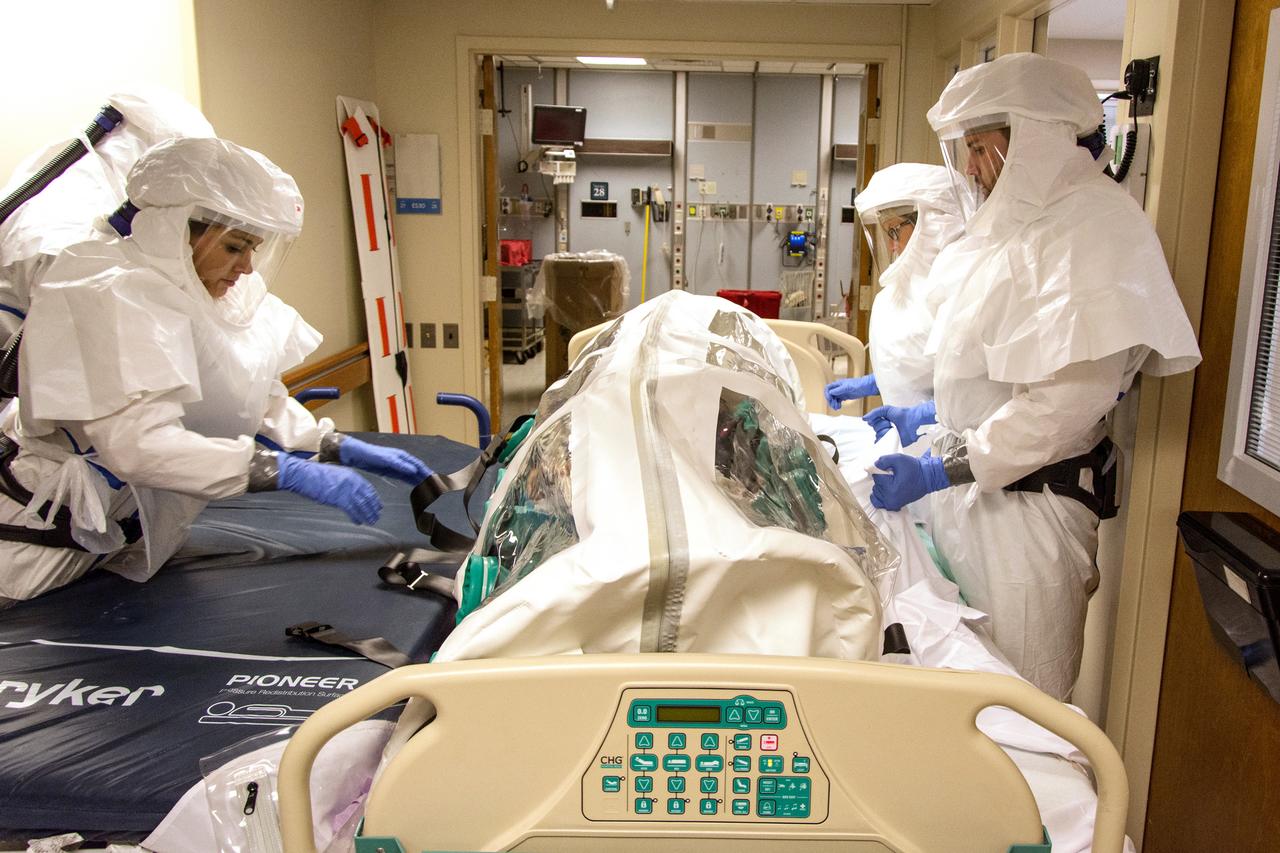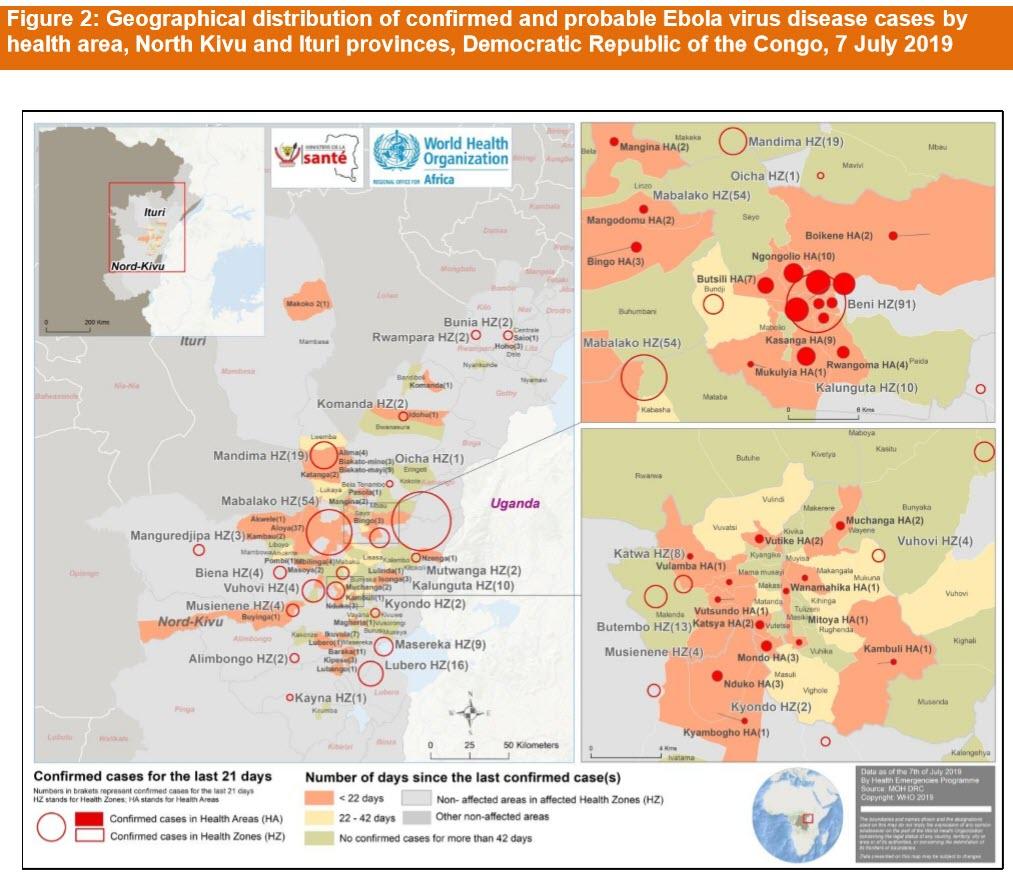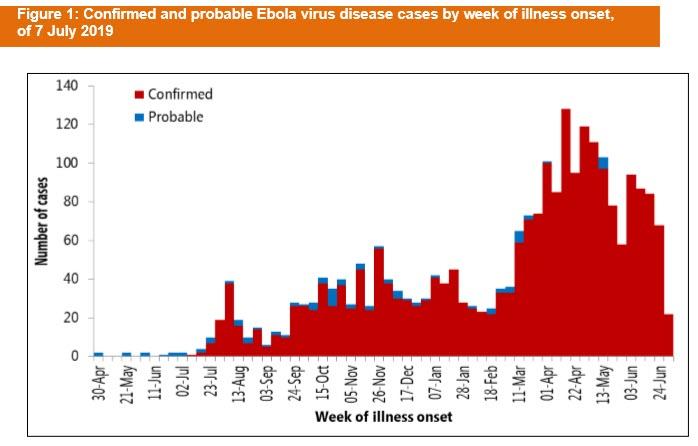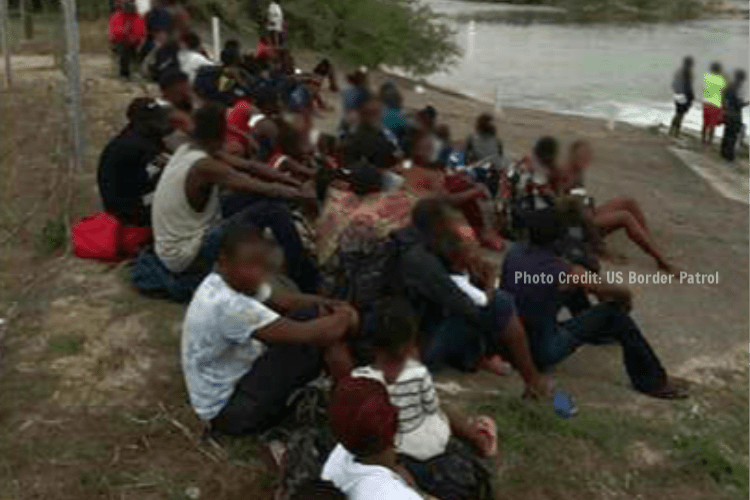Jut as we warned a month ago, the World Health Organization said today – following a meeting of experts – that the deadly Ebola outbreak in Congo has become an international public health emergency.
BREAKING NEWS: The #Ebola outbreak in #DRC constitutes a public health emergency of international concern, citing concerning geographical expansion of the virus: WHO Director-General, @DrTedros following the IHR Emergency Committee’s recommendation #alert
— World Health Organization (WHO) (@WHO) July 17, 2019
More than 1,600 people have died since August in the second deadliest Ebola outbreak in history, which is unfolding in a region described as a war zone.

As AP reports, this week the first Ebola case was confirmed in Goma, a major regional crossroads on the Rwandan border with an international airport. Experts have feared this for months.
And now, WHO Director-General Tedros Adhanom Ghebreyesus has confirmed that the health group was concerned that the virus could spread outside of the Democratic Republic of Congo.
“Although there is no evidence yet of local Ebola transmission in either Goma, DRC or Uganda, these two events represent a concerning geographical expansion of the virus,” the director general said at a press conference.
The outbreak began in August 2018 and has infected more than 2,300 people.
Interestingly, WHO does not recommend any restrictions on travel or trade, which, it says “rather than stopping Ebola, can actually hamper the fight. Such restrictions force people to use informal and unmonitored border crossings, increasing the potential for the spread of disease.”
Tedros concluded the press conference by saying:
“Now is the time for the international community to stand in solidarity with the people of DRC, not to impose punitive and counter-productive restrictions that will only serve to isolate DRC.”
However, as The Organic Prepper’s Daisy Luther recently wrote, people like to think of Ebola as a disease that only strikes superstitious locals in the deepest jungles of the Democratic Republic of Congo. But just like the last time the disease made it to our shores, there are warning signs and it’s time to start paying attention.
There are several events in the news that when looked at together, lead to concerns we could be looking at a replay of 2014.
This article is not being written to demonize people from certain regions or the world, to bring up arguments for or against immigration, or to scare the pants off you. It’s a collection of facts that I’ve written with as little bias as possible.
A quick recap of the 2014 outbreak that made its way to our shores
Everyone remembers the Ebola outbreak of 2014. It ripped through West Africa for two years, killing over 11,000 people and sickening nearly 30,000. But the reason WE remember it in the United States is that it crept into our country. Shortly after the CDC warned us to prepare for a potential Ebola pandemic, the first case was diagnosed in Dallas, Texas, when a man from West Africa visited the hospital on two occasions, having been turned away the first time as just having “the flu.” The original patient died, and two nurses caring for him caught the potentially deadly virus. One patient completely overwhelmed an entire hospital.
It is honestly shocking that more people didn’t become ill, as one nurse traveled on a plane while sick, and in another incident, a doctor in New York City who had volunteered in Guinea was also diagnosed. All in all, eleven people in the United States were treated for Ebola (that we know of, anyway) and it certainly wasn’t because of the expert handling of the near-crisis. It was pure luck.
There were all sorts of mismanagement. Everything from not requiring a quarantine of travelers returning from the affected area to housing 11 potential cases in a hotel to a ship from Liberia with sick passengers being allowed to dock in New Orleans to the near-disastrous handling of contaminated samples in Dallas, it is an absolute miracle that there was no major outbreak in the US.
If there were hundreds or thousands of patients across the country, it wouldn’t take long for things to devolve into absolute chaos. Ebola can have a death rate as high as 90%.
1) The DRC is in the midst of the second largest Ebola outbreak in history.
According to the World Health Organization, confirmed cases of Ebola have exceeded 2000 in the DRC. This makes it the second-largest outbreak in history, after the 2014-2016 epidemic.
There are several reasons that the WHO has been unable to get a handle on this outbreak. Last year, I wrote about how the families of Ebola patients were breaking them out of quarantine and taking them to prayer meetings. I also wrote that the disease had reached a major urban center, increasing the likelihood of its spread.
The area at the heart of the outbreak is a warzone, which makes it difficult for doctors to treat patients, and at the same time, the patients are untrusting of modern medicine. People are fleeing Ebola-stricken villages in fear, which just makes the spread more likely.
2) Ebola is no longer contained within the DRC
Today it was reported that Ebola has hopped the border into Uganda, where today, a young patient died. The five-year-old deceased has two relatives who have also tested positive.
Zero Hedge reports:
On Wednesday, health experts in both countries were scrambling to understand how the boy’s relatives crossed the border on June 9th, and who they may have infected along the way. The boy was taken to a Ugandan hospital after vomiting blood and exhibiting other symptoms, while two relatives of the boy also tested positive for Ebola. Uganda has been heavily screening visitors from Congo for signs of fever, and has vaccinated more than 4,700 health workers against the disease according to a joint statement by WHO and Ugandan officials.
Uganda’s health ministry said the boy’s mother, who is Congolese but married to a Ugandan and living in the Kasese district of Uganda, had travelled back to Congo to nurse her sick father, who subsequently died of Ebola. On returning to Uganda, the boy had started coughing up blood and vomiting and was taken to Kagando hospital where health workers immediately suspected Ebola.
A sample of his blood tested positive for Ebola and on Wednesday two of the boy’s relatives were also confirmed to have contracted the disease. –Financial Times (source)
Experts have warned if Ebola spreads into other countries that the virus will become even more difficult to contain.
Angola, which shares a border with the DRC, has closed that border to prevent the spread of the virus into their country.
3) The Department of Border Patrol just apprehended a large group of people from Africa
In a press release, the Border Patrol announced on May 31 that they had apprehended 116 people from Africa trying to cross the Mexican/US border.
U.S. Border Patrol agents assigned to the Del Rio Station apprehended a large group of 116 individuals Thursday.
“Large groups present a unique challenge for the men and women of the Del Rio Sector,” said Chief Raul Ortiz. “This large group from Africa further demonstrates the complexity and severity of the border security and humanitarian crisis at our Southwest border.”
Agents performing line watch operations apprehended the group after they illegally crossed the Rio Grande into the U.S. around 10:30 p.m.
This is the first large group apprehended in the Del Rio Sector and the first large group of people from Africa – including nationals from Angola, Cameroon and Congo – apprehended on the Southwest border this year. (source)
Here’s a video of the apprehension. This link came from the press release above.
4) And these aren’t the only people from the DRC coming into the United States through Mexico.
Border Patrol says that there’s an uptick of migrants from this part of the world entering the United States through the Southern border.
On June 5, agents assigned to the Eagle Pass Station arrested a group of 34 people from the continent of Africa. Since May 30, more than 500 people from the continent of Africa have been arrested by the U.S. Border Patrol in Del Rio Sector. Agents have encountered immigrants from Africa crossing the Rio Grande River in multiple separate events, including one group of over 100 individuals. These groups are primarily made up of family units from the Republic of the Congo, the Democratic Republic of the Congo and Angola. (source)
On June 6, San Antonio news station put out a desperate plea for French-speaking volunteers to help with an influx of migrants from the area. Interim Assistant City Manager Dr. Collen Bridger shared the details of the situation with KEN 5:
Bridger said the Congolese migrants began to arrive in town on Tuesday. They told Migrant Resource Center workers, they traveled with a group of about 350 migrants through Ecuador to the southern border.
“When we called Border Patrol to confirm, they said, ‘yea another 200 to 300 from the Congo and Angola will be coming to San Antonio,’” Bridger said.
That included Masengi, a Congolese migrant, who didn’t want to have his face on camera but told KENS 5 via Google Translate he arrived to the southern border as an asylum seeker.
He said he came to America for security reasons and said, “My family is staying in my country but with the help of the USA I can get it back.” (source)
San Antonio will be sending the asylum seekers to other cities across the United States.
…The city opened up the Frank Garrett Center to house the Congolese migrants for the weekend, but after that, they’re not sure where they’ll house them especially since they don’t know how long some of them will be here.
“The plan was 350 of them would travel from San Antonio to Portland. When we reached out to Portland Maine they said, ‘Please don’t send us any more. We’re already stretched way beyond our capacity,” Bridger said.
“So we’re working with them [the migrants] now to identify other cities throughout the United States where they can go and begin their asylum seeking process. (source)
Obviously, just because a person is Congolese doesn’t mean they are infected with Ebola. These are just a series of connecting facts to which we should pay attention.
At this time, there is no evidence that anyone has Ebola in the United States, including Congolese asylum seekers. Border Patrol has said this internet rumor is not true.
5) The medical screening process is overwhelmed
Another concern is the quick screening process performed by physicians at the border. There has been a massive influx of immigrants crossing through from Mexico into the United States and the system is overwhelmed.
While every person crossing has some kind of health check-up, Ebola is difficult to catch in the early stages. According to the CDC:
Diagnosing Ebola Virus Disease (EVD) shortly after infection can be difficult. Early symptoms of EVD such as fever, headache, and weakness are not specific to Ebola virus infection and often are seen in patients with other more common diseases, like malaria and typhoid fever.
To determine whether Ebola virus infection is a possible diagnosis, there must be a combination of symptoms suggestive of EVD AND a possible exposure to EVD within 21 days before the onset of symptoms (source)
I was unable to find detailed information on the exact screening process for asylum seekers crossing the border from Mexico. If someone locates it, please share it in the comments so I can update this article.
Update: Here’s a link to the CDC’s recommended screening process for refugees. It particularly notes tests for Hepatitis, HIV, parasites, malaria, STDs, and tuberculosis, along with some general tests. Keep in mind that the symptoms of Ebola may not show up for 21 days, so it’s possible for a person to pass a medical exam during the incubation period.
There are quarantine stations at all US points of entry and laws that cover isolation and quarantine. As for how long people are quarantined, it appears it may be 72 hours. There’s obviously going to be some travel time, too, but it really depends on how the asylum seeker reached the border. Did they spend months walking through Mexico on foot? If so, they would have already shown symptoms. But it has not been made clear how they arrived at the border.
(Thank you to Sandy and Lisa for this additional information.)
Conclusion
The stage is being set for what could be a catastrophe of epic proportion. Here’s what you need to know to prep for a potential Ebola outbreak in the United States and here’s a detailed book about prepping for a variety of pandemics. Here’s more information about how Ebola is transmitted.
The United States dodged the bullet last time Ebola cast its shadow here. Will we get that lucky again?
via ZeroHedge News https://ift.tt/2XSsVbn Tyler Durden



